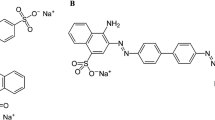Abstract
A sequential anaerobic–aerobic treatment process based on mixed culture of bacteria isolated from textile dye effluent-contaminated soil was used to degrade sulfonated azo dyes Orange G (OG), Amido black 10B (AB), Direct red 4BS (DR) and Congo red (CR). Under anaerobic conditions in a fixed-bed column using glucose as co-substrate, the azo dyes were reduced and amines were released by the bacterial biomass. The amines were completely mineralized in a subsequent aerobic treatment using the same isolates. The maximum degradation rate observed in the treatment system for OG was 60.9 mg/l per day (16.99 mg/g glucose utilized), for AB 571.3 mg/l per day (14.46 mg/g glucose utilized), for DR 112.5 mg/l per day (32.02 mg/g glucose utilized) and for CR 134.9 mg/l per day (38.9 mg/g glucose utilized).
Similar content being viewed by others
Author information
Authors and Affiliations
Additional information
Received: 6 August 1999 / Received revision: 20 December 1999 / Accepted: 24 December 1999
Rights and permissions
About this article
Cite this article
Rajaguru, P., Kalaiselvi, K., Palanivel, M. et al. Biodegradation of azo dyes in a sequential anaerobic–aerobic system. Appl Microbiol Biotechnol 54, 268–273 (2000). https://doi.org/10.1007/s002530000322
Issue Date:
DOI: https://doi.org/10.1007/s002530000322




